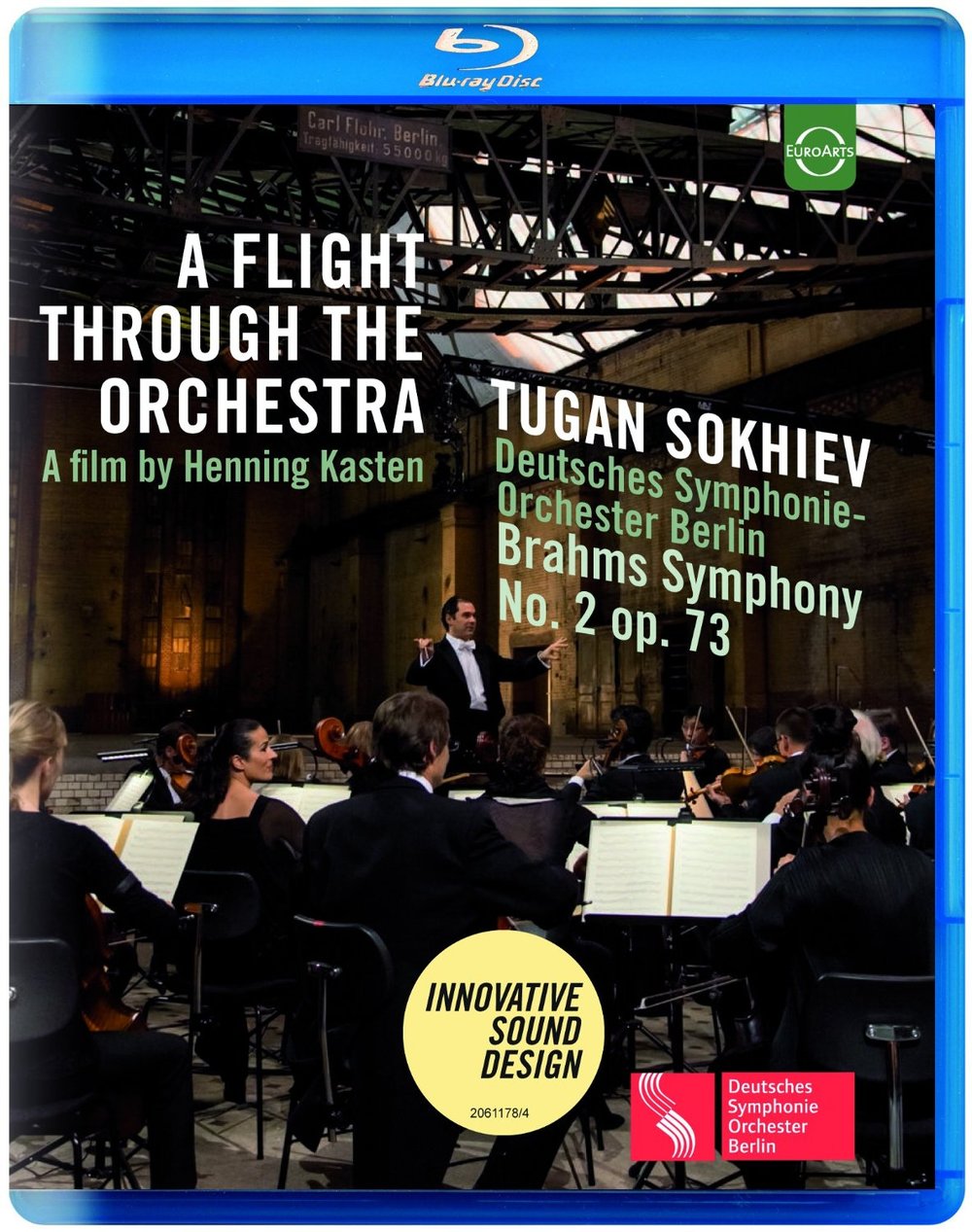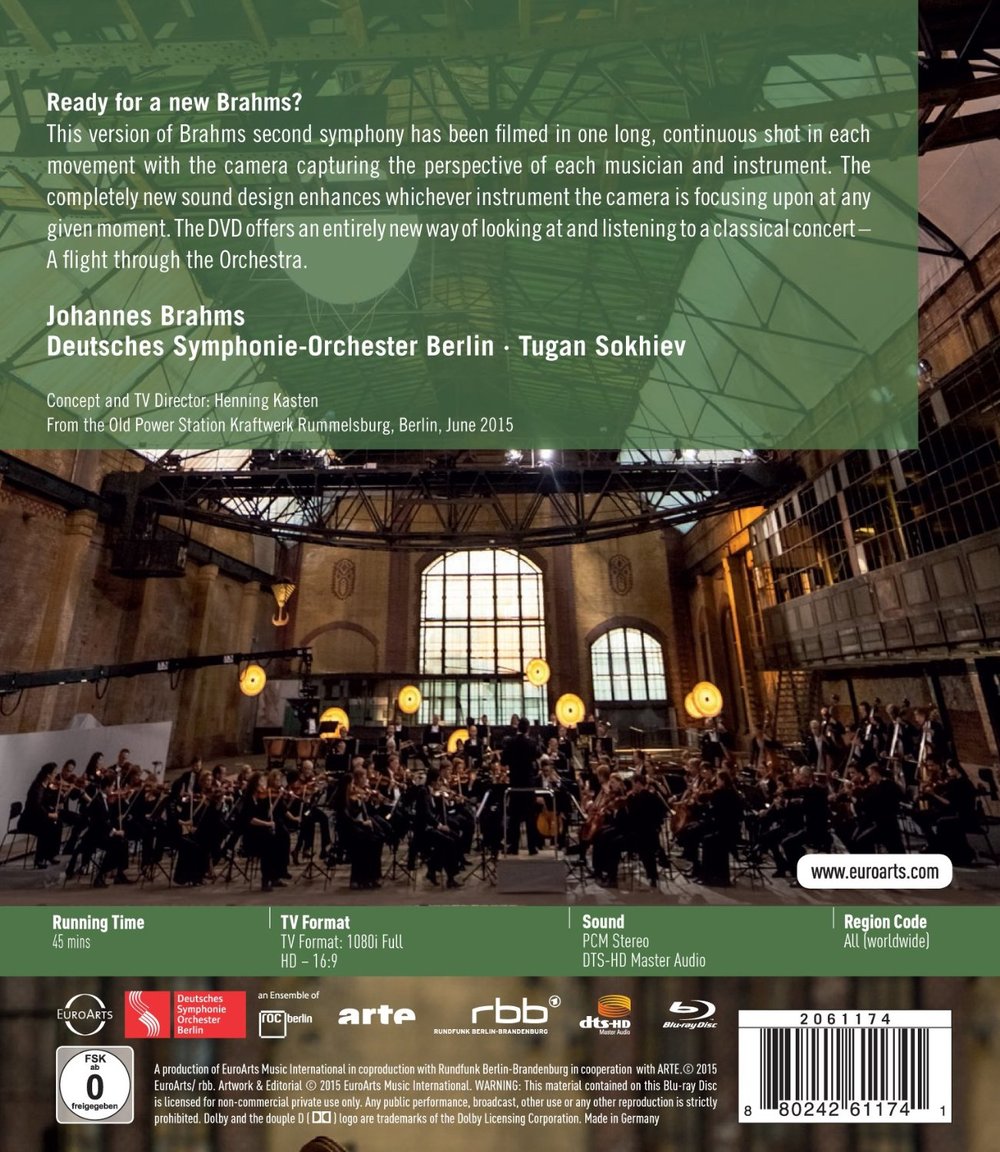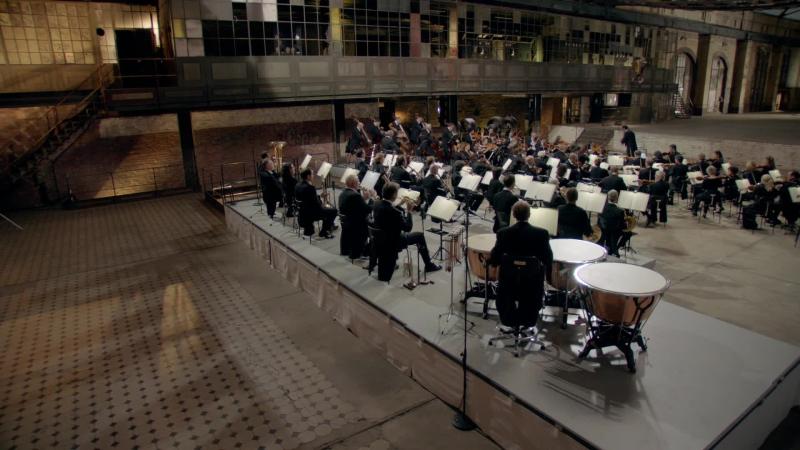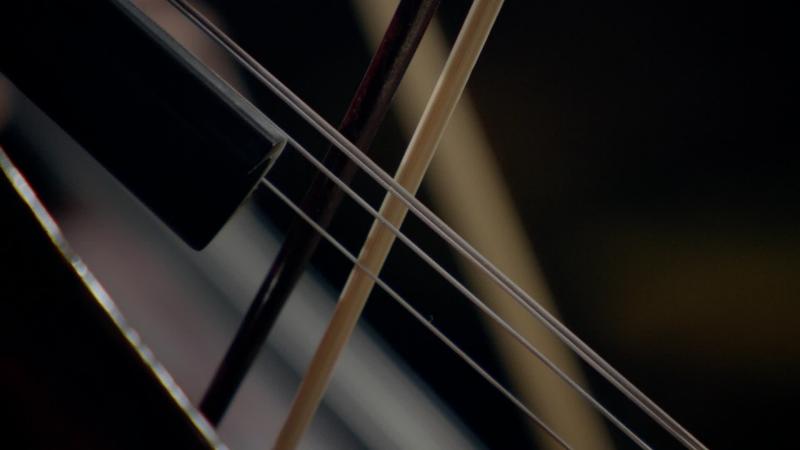

A Flight through the Orchestra: Brahms Symphony No. 2 concert. Performed June 2015 at the Rummelsburg Kraftwerk (Power Station) in Berlin. Tugan Sokhiev conducts the Deutsches Symphonie-Orchester. This was recorded with a 4K camera, but published in 2K. Released 2015, disc has 5.0 dts-HD Master Audio sound output. Grade: D-
This title was conceived and directed by videographer Henning Kasten. It's a short (45 minute) experiment in a new way to record the symphony orchestra. The video was shot using a single camera at the end of a telescopic crane which was in turn mounted on a long rail. This gear gave the camera a limited ability to move over the orchestra and to positions near some of the musicians. Each movement of the symphony is shot in a separate single take with no cuts (so there are 4 tracks of music). To avoid motion-blur and stutter, the camera moves very slowly and smoothly. The sound was also recorded in a new way. First there were normal microphones about on the stage to "recreate the overall sound of the orchestra." In addition, the flying camera was fitted with an array of 5 microphones which recorded the sound of each instrument or group of instruments the camera was focusing on at any particular time.
Henning Kasten is a videographer with significant experience in recording symphonies. 17 titles are listed on this website in which Kasten is credited with the video, mostly outdoor shows and indoor concerts in Berlin, Dresden, and Leipzig. I did a complete review of his Bruckner Symphony No. 6 at Dresden with Barenboim conducting the Berlin Staatskapelle. I diagnosed a "dreadful case" of DVDitis for that title and gave it a C+. I did not blame Kasten for the DVDitis—I blamed management for hiring Kasten to film a DVD that was also published in Blu-ray as an additional profit center. But I do note that Kasten, like other videographers, has been exposed to many bad habits that poison our classical music HDVDs. Kasten faired — a bit better with his 2015 Sommernachtskoncert at the Schönbrunn Palace in Vienna, which I graded "B."
Now to Kasten's experiment. The disk has 6 tracks, one for an introduction, one for each movement in the music, and one for credits at the end. There is nothing else on the disc—no extras or Euroarts trailers. The keepcase booklet has a couple of typical pages about the music and the orchestra. There is next to nothing said in the booklet about the crane or technical aspects of the experiment other than what I've already explained above.
There is no image of the crane (or its shadow) in the video, on the disc (no extras), or in the keepcase booklet. But there is a poor photo of the crane on the back of the keepcase, and you can see this fairly well above in my screenshot of the keepcase artwork. The crane has a base and 3 smaller telescopic extensions. A boxy-looking camera appears to hang about 4 feet below the end of the crane. It appears the camera can pivot maybe 270 degrees to shoot in various directions from the position reached by the crane. In the keepcase photo, you see a white "sheet" about 6 feet tall that runs along the side of the orchestra. I think that sheet might be the "rail" that supports the crane. I doubt there is much new or "high-tech" about this hardware. I do think that sophisticated computer software is needed to safely control the gear.
The show begins with Sokhiev already on the podium starting the 1st movement. Kasten says in the booklet that the crane can access "almost every position within and above the orchestra." This is, as you will see later, a bit of puffing: the positions the camera can reach with its lens are in fact quite limited. Also Kasten says nothing about another serious shocker: the crane and camera cannot get any shot of the whole orchestra from the front. It is the duty of every videographer to start a video of a symphony with solid shots of the whole orchestra. The screenshot below is the best Kasten can do with the limited reach of his crane. But this is not a whole-orchestra shot for several reasons. First, it's so far back that the orchestra doesn't take up the whole frame. About 20% of the screen on the right is wasted on an image of the old building. Second, the shot is off-center. Third, a whole rank of violins is chopped off on the left. Because the camera is so far back and the orchestra seating is arranged over a large area, the resolution of the image is unacceptably poor on my display in my HT. The resolution does look slightly better in the HT than in this screenshot:
Oddly, the crane can get a whole-orchestra shot of sorts from the rear. In the picture below you see the missing-in-action violins on a riser on the right. But an old crane hook hanging from the ceiling ruins the shot. Strangely, this is the view that Kasten selects to end his video—it has to be the weakest ending of a symphony video I've seen:
So there is not a single useful whole-orchestra shot in this entire video. The next screenshot below is, I think, about the best Kasten can do to show the orchestra generally— a part-orchestra shot. Another irritating problem with Kasten's crane set-up is that he can't show all the violins. Below you see all the 2nd violins and maybe half the 1st violins, and that about as good as it gets. This view also lets you see better how spread-out the players are. Why is that? Well, Kasten can't get close to the players with his crane and dangling camera if the players are seated near each other as they normally would be. To get close-ups, Kasten creates big gaps in the seating. Look closely and you will see a "middle alley" that runs all along the rear of the violins and cellos up to a riser that holds the double-basses. And there's a big gap between the horns and the woodwinds:
Here's another view of the middle alley:
And below is a view of a "back alley" that runs in front of the tympani and the lower brass. These alleys and gaps can be used as safe areas for the crane and camera to enter for close-ups. Oddly, I don't think Kasten used the back alley much in the video:
Now we see a a well-composed shot of the woodwinds. The crane has run out most or all of its length and the camera is dangling down shooting to its left. By now you are probably wondering about the resolution of this 2K video. Yes, it's disappointing. There seems to be too much light which causes the whole video to be slightly washed out and hazy. You can't see the notes on the sheet music like you can when there's sharp resolution. The constant movement of the camera may cause deterioration in image quality. And the depth-of-field-of-focus also seems to be a problem. Some of the time the image is so bad you would think it could be an doctored SD film, but I'm sure that's not the case:
Now we move to the next shot below of the part of the basses. The crane is lowered and the camera points straight ahead. This is a part-section shot. If the basses are doing something significant here, why not shoot the whole section? I don't thing Kasten can get his crane close to all the basses, who are located on the opposite side of the stage from the rail supporting the crane. If he wanted to show all the basses, he would have to show a bigger view with a bunch of cellos and violas also in the picture. That would be, in my view, better than the dinky shot we have here of the big boys. In the keepcase booklet, Kasten says the crane allows the video to follow "the flow of the music." I question whether this part-section shot had any particular relationship to the "flow of the music." I think this shot appears because it was easy to get:
Here's a lady whom I call "Topknot." You see her so many times you would think she is the principal cello. But of course, she's not. She's one of the back-row cellos and usually plays when the whole section is committed. She happens to sit at a corner of the middle alley and a large gap between the cellos and the 2nd violins. She's in the video a lot because she is easy to reach with the camera. Again I wonder what this shot has to do with the flow of the music:
Here's "Blondie." We see her several times. She's on the back row of the violins in another place where the crane can easily dangle the camera:
Below are two more shots along the middle alley. By now you may be getting a sense of how tricky it is to mix a long steel crane with powerful electric motors in with a population of soft people dressed in evening clothes carrying expensive and fragile musical instruments. The crane might be controlled by a person with a joystick of some kind. What would happen if someone accidentally bumped into the joystick operator who then jerked the joystick involuntarily? Could the crane then wipe out the horns before dumping the trumpets and the kettledrums off the back of the rear riser? Well, I doubt this could happen. Surely Kasten spent a lot of effort and money carefully determining where all the players would be sitting and then programming the computers so the crane could not enter fleshspace:
That's enough of the middle alley. Another way to get the camera close to players is to place the crane along the front of the orchestra. Along the way to that position, you might well be forced to take the worthless shot below of the backs of the 1st violins. At first I didn't understand why Kasten picked this Brahms symphony for his experiment, since Brahms has most or all of his forces playing all the time, often with multiple themes blended together. But now I understand: if everyone is playing, it's easy to slowly move the camera from one player to another nearby. If Kasten had picked a score that really moves the music around, like, say, the Ravel Bolero, he would have had a real problem. Bolero moves the melody fast, but the crane moves slow to prevent ridiculous motion blur and stutter. By the time the camera reaches the Bolero solo trombone, the melody has just decamped to the saxophone:
Now the crane is in position in front of the band. It extends toward the conductor and the camera points to the left. This results in the screenshot below of a 1st violin player on the edge of the orchestra. She is in-focus. But the field-of-focus is so shallow that everybody else in out-of-focus. This is sad. To see what a great video of a symphony should look like, see the NHK recording of the Brahms Symphony No. 2 played by the Saito Kinen Orchestra under Seiji Ozawa and/or the NHK Bruckner Symphony No. 9 played by the Concertgebouw Orchestra under Bernard Haitink:
Here's the concert master in-focus with everybody else looking fuzzy:
Why make a shot of the back of the conductor? Well, having come this far, the crane and camera can't help it:
If there will be no views of the whole orchestra, the videographer must try to recover by coming up with decent part-orchestra or multiple section shots. We already saw a part-orchestra shot above. The view below is quite good in showing the lower strings and much of the winds. Alas, there are by my count only 6 occasions in the video when Kasten provides good multiple section shots like this. And it's unfortunate that the camera can't reach far enough to make shots of this nature in the direction of the violins:
In a good symphony video, there should be shots of whole sections playing. In this department, Kasten does well. Here a good view of the violas:
And below are two more small section shots easily reached from the middle alley:
And here's a nice shot of the horns---but isn't it a silly error to capture them when they are resting?
A good video will surely have some close-ups. The most aggressive close-up in the whole piece was the shot of the clarinet player below. How did Kasten do this? This was set up with the camera shut down between 2nd and 3rd movements. I suspect one or more other players may have had to move out of the way for some seconds while the camera got to this position and later moved on. The notion that Kasten's approach can take us "on a journey into the midst of a performing orchestra" is, I think, still a fantasy. To really do this the TV director would have to put all the players on a 4-foot by 4-foot grid like a marching band in a giant rectangle formation. Then, with more flexible camera gear (maybe a drone!), he could maybe "make a journey in the midst." But then there would no longer be a symphony orchestra:
Next below is a view of the principal horn in a solo. Now let's turn our attention to Kasten's new sound system that emphasises the sound of the instrument being photographed with microphones connected to the camera. I was able to hear this special effect most of the time when the camera was pointed at a small section. But in this shot of the solo horn, the new sound design was overwhelming. Any time a video camera shows a particular object that can make a sound, the human brain will automatically turn attention to whatever sound that object is making. This is hard-wired in all of us. If you see a snake, you want to know if it's rattling. If you see an enemy soldier, you want to know if he's screaming a war cry or begging to surrender. It's also true, I think, that the horn makes a penetrating noise at any volume level. However loud the horn is playing, focusing the video on the horn will amplify the sound. And adding 5 extra microphones on the video camera increases the volume more. So when I see the shot below in my HT, I hardly can hear anything else from the rest of the orchestra. Is that what Brahms wanted me to hear when he wrote these notes for the horn? I don't think so. I think Brahms wanted me the hear all the instruments marked in the score playing in harmonious unity with the horn only highlighted:
One of the main symptoms of DVDitis is making too much video of the conductor. This happen because it's so much easier to make a shot of the conductor than to deal with all the complexities of shooting symphony musicians for a DVD. So how does Kasten treat the conductor in subject title? As I describe in more detail later, Kasten devotes roughly 1/3 of his film to shots of Sokhiev providing a beat. Below is a very pretty shot of Sokhiev starting the last movement. I have no problem with seeing this a few times, but 11 times in 45 minutes is too much:
And far worse are the 23 times that we see the conductor far away over the backs of the musicians. This is like filling the bottle 2/3rds with wine and then adding 1/3rd water before driving in the cork:
There are quite a few nice shots of the orchestra in Kasten's experiment. But with only one camera, how do you get from one nice scene to the next? You get there with low-value or worthless panning and zooming at slow speed (to avoid blur and stutter). If you make a mistake, you own it—there's no recovery or fix. The bald-head shot below is one such mistake:
And there are many other low-value images as the camera hopelessly moves about trying to keep up with the music:
Finally, below is of another lazy shot, a bow moving over strings. And whose bow is this? Why, it's Topknot on the back row of the cellos.
I'm sure The Deutsches Symphonie-Orchester is capable of playing a thrilling Brahms symphony. But this was probably a hectic experience for everyone, and the SQ of the recording is weak. Too often I heard little or nothing from many of the instruments that I could see playing. In particular, many times I saw strings being plucked, but I heard no distinctive pizzicato sounds. I heard little vitality from the orchestra as a whole.
Maybe I'm being too negative. I also have some good things also to point out. First, its great to get a title where the emphasis is on trying to make a high-definition Blu-ray and not a standard-definition DVD. I hope the market is reached the point where more classical symphony Blu-rays will be sold than DVDs. If that's the case, then maybe we can finally focus on making the best HD symphony videos we can.
Kasten's experiment produces a slower and more relaxed pace for the viewer than the hectic "Road Runner" videos we have been getting for years in our HDVD symphony concerts. There are no cuts within a movement. But the camera does have a tendency to move from one "tableaux" to another. This is highly subjective, but I count the following tableaux: 11 of the conductor only, 23 of the conductor over the backs of the players, 6 part-orchestra, 2 whole sections, 17 multiple sections, 13 small sections, 13 part-sections, 11 solos, and 1 instrument-only shot. This is a total of 97 tableaux. There are 2425 seconds of music. This works out to 25 seconds of music per tableaux. In comparison, HDVDs with bad cases of DVDitis tend to have cuts that last as few as 5 seconds on average. So watching Kasten's experiment is far more relaxing than most of the symphony HDVDs we now have.
But now I must ask a final critical question: Is Kasten here going too far in trying to usurp the traditional prerogatives of the composer and conductor? The composer puts as much on paper as he knows how. The conductor spends his entire life learning how to best interpret the written score. Is there room now for yet another person to enter the picture in the case of recordings to focus the attention of the audience in special ways and to also change the sound of the orchestra in accordance with those special ways? Should Brahms, Sokhiev, and Kasten get equal billing on the keepcase cover?
The future will tell. As technology reduces the size and weight of electronic gear, maybe it will possible to give one or several flying cameras more mobility in speed and range with no potential for danger to the musicians. Maybe the more flexible cameras can operate without having to carve the orchestra up into blocks with access alleys. If the flying camera idea catches on with consumers, then we may soon have a 4K version of this title which might have better video resolution and better sound than subject title.
But rather than trying to invent new things, I wish Kasten and his comrades in the industry would, for now anyway, focus more on making better HDVDs with tried and proven techniques we already have. I wish they would study all the wonderful A+ NHK symphony titles which I've listed in a special report on this website. Then they could learn how to make videos that meet our standards for the good symphony HDVD.
In the meantime, I don't think subject title has much appeal to consumers with its short 45 minutes of music, ugly spread-out configuraton of the orchestra, soft resolution, sharp limitations on camera mobility, odd and disruptive sound design, and poor video content. This title will perhaps have appeal to industry experts. Under my grading system, I'll give this a D-. Buy if you have a really good reason.
OR




























